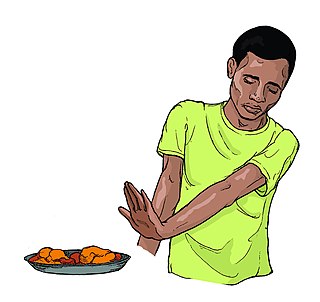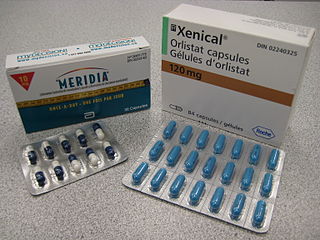Related Research Articles

Anorexia is a medical term for a loss of appetite. While the term outside of the scientific literature is often used interchangeably with anorexia nervosa, many possible causes exist for a loss of appetite, some of which may be harmless, while others indicate a serious clinical condition or pose a significant risk.
An eating disorder is a mental disorder defined by abnormal eating behaviors that negatively affect a person's physical or mental health. Types of eating disorders include binge eating disorder, where the patient eats a large amount in a short period of time; anorexia nervosa, where the person has an intense fear of gaining weight and restricts food or overexercises to manage this fear; bulimia nervosa, where individuals eat a large quantity (binging) then try to rid themselves of the food (purging); pica, where the patient eats non-food items; rumination syndrome, where the patient regurgitates undigested or minimally digested food; avoidant/restrictive food intake disorder (ARFID), where people have a reduced or selective food intake due to some psychological reasons; and a group of other specified feeding or eating disorders. Anxiety disorders, depression and substance abuse are common among people with eating disorders. These disorders do not include obesity. People often experience comorbidity between an eating disorder and OCD. It is estimated 20–60% of patients with an ED have a history of OCD.

Bulimia nervosa, also known as simply bulimia, is an eating disorder characterized by binge eating followed by purging or fasting, and excessive concern with body shape and weight. This activity aims to expel the body of calories eaten from the binging phase of the process. Binge eating refers to eating a large amount of food in a short amount of time. Purging refers to the attempts to get rid of the food consumed. This may be done by vomiting or taking laxatives.
Appetite is the desire to eat food items, usually due to hunger. Appealing foods can stimulate appetite even when hunger is absent, although appetite can be greatly reduced by satiety. Appetite exists in all higher life-forms, and serves to regulate adequate energy intake to maintain metabolic needs. It is regulated by a close interplay between the digestive tract, adipose tissue and the brain. Appetite has a relationship with every individual's behavior. Appetitive behaviour also known as approach behaviour, and consummatory behaviour, are the only processes that involve energy intake, whereas all other behaviours affect the release of energy. When stressed, appetite levels may increase and result in an increase of food intake. Decreased desire to eat is termed anorexia, while polyphagia is increased eating. Dysregulation of appetite contributes to anorexia nervosa, bulimia nervosa, cachexia, overeating, and binge eating disorder.
Binge eating disorder (BED) is an eating disorder characterized by frequent and recurrent binge eating episodes with associated negative psychological and social problems, but without the compensatory behaviors common to bulimia nervosa, OSFED, or the binge-purge subtype of anorexia nervosa.
Binge eating is a pattern of disordered eating which consists of episodes of uncontrollable eating. It is a common symptom of eating disorders such as binge eating disorder and bulimia nervosa. During such binges, a person rapidly consumes an excessive quantity of food. A diagnosis of binge eating is associated with feelings of loss of control. Binge eating disorder is also linked with being overweight and obesity.
Polyphagia or hyperphagia is an abnormally strong, incessant sensation of hunger or desire to eat often leading to overeating. In contrast to an increase in appetite following exercise, polyphagia does not subside after eating and often leads to rapid intake of excessive quantities of food. Polyphagia is not a disorder by itself; rather, it is a symptom indicating an underlying medical condition. It is frequently a result of abnormal blood glucose levels, and, along with polydipsia and polyuria, it is one of the "3 Ps" commonly associated with uncontrolled diabetes mellitus.

Anti-obesity medication or weight loss medications are pharmacological agents that reduce or control excess body fat. These medications alter one of the fundamental processes of the human body, weight regulation, by: reducing appetite and consequently energy intake, increasing energy expenditure, redirecting nutrients from adipose to lean tissue, or interfering with the absorption of calories.
A food addiction or eating addiction is any behavioral addiction that is primarily characterized by the compulsive consumption of palatable food items which markedly activate the reward system in humans and other animals despite adverse consequences.
Nocturnal sleep-related eating disorder (NSRED) is a combination of a parasomnia and an eating disorder. It is a non-rapid eye movement sleep (NREM) parasomnia. It is described as being in a specific category within somnambulism or a state of sleepwalking that includes behaviors connected to a person's conscious wishes or wants. Thus many times NSRED is a person's fulfilling of their conscious wants that they suppress; however, this disorder is difficult to distinguish from other similar types of disorders.

Anorexia nervosa (AN), often referred to simply as anorexia, is an eating disorder characterized by low weight, food restriction, body image disturbance, fear of gaining weight, and an overpowering desire to be thin.

Weight management refers to behaviors, techniques, and physiological processes that contribute to a person's ability to attain and maintain a healthy weight. Most weight management techniques encompass long-term lifestyle strategies that promote healthy eating and daily physical activity. Moreover, weight management involves developing meaningful ways to track weight over time and to identify ideal body weights for different individuals.

Many memory impairments exist as a result from or cause of eating disorders. Eating disorders (EDs) are characterized by abnormal and disturbed eating patterns that affect the lives of the individuals who worry about their weight to the extreme. These abnormal eating patterns involve either inadequate or excessive food intake, affecting the individual's physical and mental health.
Other specified feeding or eating disorder (OSFED) is a subclinical DSM-5 category that, along with unspecified feeding or eating disorder (UFED), replaces the category formerly called eating disorder not otherwise specified (EDNOS) in the DSM-IV-TR. It captures feeding disorders and eating disorders of clinical severity that do not meet diagnostic criteria for anorexia nervosa (AN), bulimia nervosa (BN), binge eating disorder (BED), avoidant/restrictive food intake disorder (ARFID), pica, or rumination disorder. OSFED includes five examples:
Hedonic hunger or hedonic hyperphagia is "the drive to eat to obtain pleasure in the absence of an energy deficit." Particular foods may have a high "hedonic rating" or individuals may have increased susceptibility to environmental food cues. Weight loss programs may aim to control or to compensate for hedonic hunger. Therapeutic interventions may influence hedonic eating behavior.
Sleep and weight is the association between the amount of sleep an individual obtains and the weight of that individual.

Thomas A. Wadden is a clinical psychologist and educator who is known for his research on the treatment of obesity by methods that include lifestyle modification, pharmacotherapy, and bariatric surgery. He is the Albert J. Stunkard Professor of Psychology in Psychiatry at the Perelman School of Medicine at the University of Pennsylvania and former director of the university's Center for Weight and Eating Disorders. He also is visiting professor of psychology at Haverford College.

Albert J. ("Mickey") Stunkard was an American psychiatrist. He is known for his first descriptions of binge eating disorder and night eating syndrome in the 1950s.

Hyperpalatable food (HPF) combines high levels of fat, sugar, sodium, or carbohydrates to trigger the brain's reward system, encouraging excessive eating. The concept of hyperpalatability is foundational to ultra-processed foods, which are usually engineered to have enjoyable qualities of sweetness, saltiness, or richness. Hyperpalatable foods can stimulate the release of metabolic, stress, and appetite hormones that play a role in cravings and may interfere with the body's ability to regulate appetite and satiety.
The Night Eating Questionnaire (NEQ) is one of the most widely used measures for the assessment of night eating syndrome. The original NEQ was revised several times and its current version was published by Allison and colleagues in 2008. The NEQ has 14 items and responses are recorded on a five-point scale from 0 to 4 with each item having different response labels. Additional items for assessing perceived distress and functional impairment can be used but these are not included in the total score.
References
- 1 2 3 Allison; et al. (2010). "Proposed Diagnostic Criteria for Night Eating Syndrome". International Journal of Eating Disorders. 43 (3): 241–247. doi:10.1002/eat.20693. PMC 4531092 . PMID 19378289.
- ↑ Stunkard A.J.; Grace W.J.; Wolff H.G. (1955). "The night-eating syndrome; a pattern of food intake among certain obese patients". The American Journal of Medicine. 19 (1): 78–86. doi:10.1016/0002-9343(55)90276-X. PMID 14388031.
- ↑ American Psychiatric Association. (2013). Diagnostic and statistical manual of mental disorders (5th ed.).Washington, DC: Author.
- ↑ Striegel-Moore R.H.; Franko D.L.; Thompson D.; Affenito S.; Kraemer H.C. (2006). "Night eating: Prevalence and demographic correlates". Obesity. 14 (1): 139–147. doi: 10.1038/oby.2006.17 . PMID 16493132.
- ↑ Rand C.S.W.; Macgregor M.D.; Stunkard A.J. (1997). "The night eating syndrome in the general population and amongst post-operative obesity surgery patients". International Journal of Eating Disorders. 22 (1): 65–69. doi:10.1002/(sici)1098-108x(199707)22:1<65::aid-eat8>3.0.co;2-0. PMID 9140737.
- ↑ Stunkard A.J.; Berkowitz R.; Wadden T.; Tanrikut C.; Reiss E.; Young L. (1996). "Binge eating disorder and the night-eating syndrome". International Journal of Obesity. 20 (1): 1–6. PMID 8788315.
- ↑ Wal Jillon S. Vander (2012). "Night eating syndrome: A critical review of the literature". Clinical Psychology Review. 32 (1): 49–59. doi:10.1016/j.cpr.2011.11.001. PMID 22142838.
- ↑ Lundgren J.D.; Drapeau V.; Allison K.C.; Gallant A.R.; Tremblay A.; Lambert M.A.; Stunkard A.J. (2012). "Prevalence and familial patterns of night eating in the Quebec adipose and lifestyle investigation in youth (QUALITY) study". Obesity. 20 (8): 1598–1603. doi: 10.1038/oby.2012.80 . PMID 22469955.
- 1 2 3 Birketvedt G.; Florholmen J.; Sundsfjord J.; Østerud B.; Dinges D.; Bilker W.; Stunkard A.J. (1999). "Behavioral and neuroendocrine characteristics of the night-eating syndrome". Journal of the American Medical Association. 282 (7): 657–663. doi: 10.1001/jama.282.7.657 . PMID 10517719.
- ↑ Auger R.R. (2006). "Sleep-related eating disorders". Psychiatry. 3 (11): 64–70. PMC 2945843 . PMID 20877520.
- ↑ Shoar S.; Shoar N.; Khorgami Z.; Shahabuddin Hoseini S.; Naderan M. (2012). "Prophylactic diet: A treatment for night eating syndrome". Hypothesis. 10 (1): e5.
- 1 2 3 4 5 Young, SN (2007), "How to increase serotonin in the human brain without drugs", J Psychiatry Neurosci, 32 (6): 394–399, PMC 2077351 , PMID 18043762.
- ↑ O'Reardon J.P.; Stunkard A.J.; Allison K.C. (2004). "Clinical trial of sertraline in the treatment of night eating syndrome". International Journal of Eating Disorders. 35 (1): 16–26. doi:10.1002/eat.10224. PMID 14705153.
- ↑ Lundgren J.D.; Shapiro J.R.; Bulik C.M. (2008). "Night eating patterns of patients with bulimia nervosa: a preliminary report". Eating and Weight Disorders - Studies on Anorexia, Bulimia and Obesity. 13 (4): 171–175. doi:10.1007/bf03327503. PMID 19169072. S2CID 39452993.
- ↑ Morse S.A.; Ciechanowski P.S.; Katon W.J.; Hirsch I.B. (2006). "Isn't this just bedtime snacking? The potential adverse effects of night-eating symptoms on treatment adherence and outcomes in patients with diabetes". Diabetes Care. 29 (8): 1800–1804. doi: 10.2337/dc06-0315 . PMID 16873783.
- ↑ Gluck M.E.; Geliebter A.; Satoy T. (2001). "Night eating syndrome is associated with depression, low self-esteem, reduced daytime hunger, and less weight loss in obese patients". Obesity Research. 9 (4): 264–267. doi:10.1038/oby.2001.31. PMID 11331430.
- ↑ Calugi S.; Grave R.D.; Marchesini G. (2009). "Night eating syndrome in class II-III obesity: Metabolic and psychopathological features". International Journal of Obesity. 33 (8): 899–904. doi:10.1038/ijo.2009.105. PMID 19506562. S2CID 22424244.
- ↑ Boseck J.J.; Engel S.G.; Allison K.C.; Crosby R.D.; Mitchell J.E.; de Zwaan M. (2007). "The application of ecological momentary assessment to the study of night eating". International Journal of Eating Disorders. 40 (3): 271–276. doi:10.1002/eat.20359. PMID 17177212.
- ↑ Allison K.C.; Ahima R.S.; O'Reardon J.P.; Dinges D.F.; Sharma V.; Cummings D.E.; Stunkard A.J. (2005). "Neuroendocrine profiles associated with energy intake, sleep, and stress in the night eating syndrome". Journal of Clinical Endocrinology and Metabolism. 9 (11): 6214–6217. doi: 10.1210/jc.2005-1018 . PMID 16131578.
- ↑ Striegel-Moore R.H.; Franko D.L.; Thompson D.; Affenito S.; May A.; Kraemer H.C. (2008). "Exploring the typology of night eating syndrome". International Journal of Eating Disorders. 41 (5): 411–418. doi:10.1002/eat.20514. PMID 18306340.
- 1 2 De Zwaan M.; Roerig D.B.; Crosby R.D.; Karaz S.; Mitchell J.E. (2006). "Nighttime eating: a descriptive study". International Journal of Eating Disorders. 39 (3): 224–232. doi:10.1002/eat.20246. PMID 16511835.
- 1 2 Lundgren J.D.; Allison K.C.; O'Reardon J.P.; Stunkard A.J. (2008). "A descriptive study of non-obese persons with night eating syndrome and a weight-matched comparison group". Eating Behaviors. 9 (3): 343–351. doi:10.1016/j.eatbeh.2007.12.004. PMC 2536488 . PMID 18549994.
- ↑ Thompson S.H.; DeBate R.D. (2010). "An exploratory study of the relationship between night eating syndrome and depression among college students". Journal of College Student Psychotherapy. 24: 39–48. doi:10.1080/87568220903400161. S2CID 144201491.
- ↑ Sassaroli S.; Ruggiero G.M.; Vinai P.; Cardetti S.; Carpegna G.; Ferrato N.; Sampietro S. (2009). "Daily and nightly anxiety amongst patients affected by night eating syndrome and binge eating disorder". Eating Disorders. 17 (2): 140–145. doi:10.1080/10640260802714597. PMID 19242843. S2CID 25666116.
- ↑ Napolitano M.A.; Head S.; Babyak M.A.; Blumenthal J.A. (2001). "Binge eating disorder and night eating syndrome: psychological and behavioral characteristics". International Journal of Eating Disorders. 30 (2): 193–203. doi:10.1002/eat.1072. PMID 11449453.